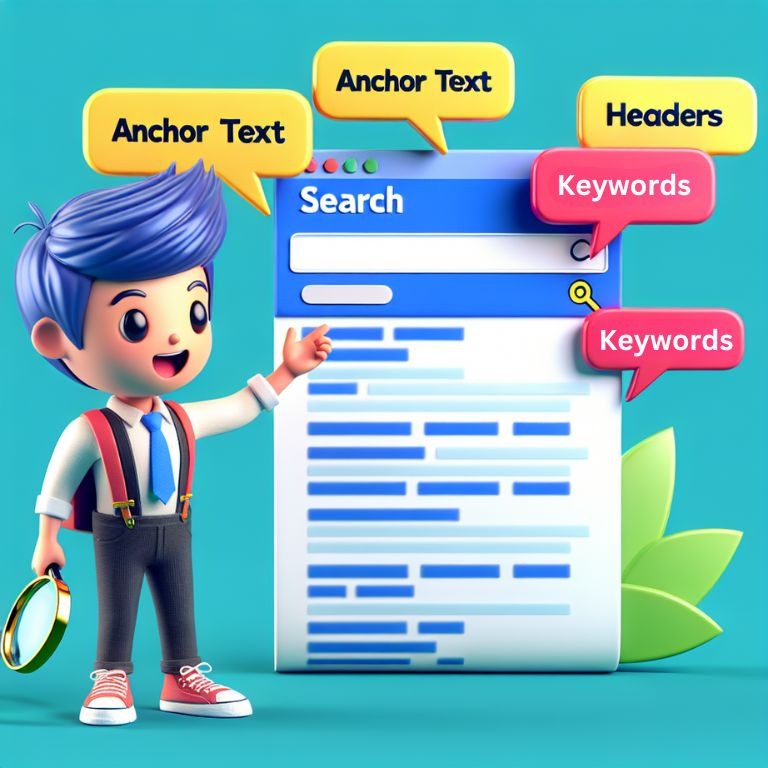Hey there! ? Are you ready to dive
into the world of Search Engine Optimization (SEO)? Don't worry if you're new
to this – we're going to break it down in a way that's super easy to
understand. By the end of this article, you'll know all about anchor texts, H1
and H2 tags, and how to use keywords to boost your Google rankings. Let's get
started!
Key Takeaways
- Anchor texts are clickable words in hyperlinks that help both users and search engines understand what the linked page is about.
- H1 tags are like the main headline of your webpage, while H2 tags are subheadings that organize your content.
- Using relevant keywords throughout your content helps search engines understand what your page is about and rank it accordingly.
- A balanced approach to SEO, focusing on user experience and natural content, is key to success.

What Are Anchor Texts and Why Do They Matter?
Imagine you're reading a book, and you come across a footnote. That little number tells you there's more information somewhere else in the book. Well, anchor texts are like digital footnotes for the internet!
An anchor text is the clickable text in a hyperlink. It's usually blue and underlined, like this: Click here to learn more about SEO. The words "Click here to learn more about SEO" are the anchor text.
Why are anchor texts important?
- They give readers a clue about what they'll find if they click the link.
- Search engines use them to understand what the linked page is about.
For example, if you have a link with the anchor text "best chocolate chip cookie recipe," Google thinks, "Aha! This linked page is probably about making yummy cookies!" ?
Tips for using anchor texts:
- Be descriptive: Instead of "click here," use "check out our free SEO guide."
- Keep it natural: Don't stuff keywords unnaturally.
- Mix it up: Use different anchor texts to link to the same page.
More Anchor Text Examples:
- Generic: "Click here" (not recommended)
- Branded: "Learn more about Moz's SEO tools"
- Naked URL: "Visit https://www.example.com for more information"
- Exact match: "best SEO practices" (linking to a page about SEO best practices)
- Partial match: "tips for improving your search rankings"
- Related: "boost your website's visibility" (linking to an SEO guide)
Did you know? According to a study by Ahrefs, pages with exact match anchor text (where the anchor text exactly matches the target keyword) ranked higher in 69.9% of cases.
H1 and H2 Tags: The Traffic Signs of Your Content
Now, let's talk about H1 and H2 tags. Think of your webpage as a road trip, and these tags are like road signs guiding the way.
What's an H1 Tag?
The H1 tag is like the big "Welcome to Las Vegas" sign. It's the main headline of your page and usually appears at the top. You should only have one H1 per page.
Example:
<h1>10 Delicious Chocolate Chip Cookie Recipes</h1>
What about H2 Tags?
H2 tags are like the signs that say "Downtown →" or "Beach 5 miles." They're subheadings that organize your content into sections.
Example:
<h2>Classic Chocolate Chip Cookies</h2>
<h2>Vegan Chocolate Chip Cookies</h2>
<h2>Gluten-Free Options</h2>
Why are H1 and H2 tags important?
- They help readers scan your content quickly.
- Search engines use them to understand the structure and topic of your page.
- They can improve accessibility for people using screen readers.
Where Should H1 and H2 Tags Appear on Your Website?
H1 Tags:
- The H1 tag should appear at the top of your content area, typically right after the header or navigation menu.
- It should be the first thing users see when they start reading your main content.
- You should have only one H1 tag per page.
H2 Tags:
- H2 tags should be used to break up your content into main sections.
- They typically appear throughout the body of your content, introducing new topics or ideas.
- You can have multiple H2 tags on a single page.
Examples of H1 and H2 Tag Placement:
Homepage:
<header>
<!-- Navigation menu -->
</header>
<main>
<h1>Welcome to Our Gourmet Bakery</h1>
<section>
<h2>Our Bestselling Treats</h2>
<!-- Content about bestsellers -->
</section>
<section>
<h2>This Week's Specials</h2>
<!-- Content about special offers -->
</section>
</main>
Blog Post:
html
Copy
<article>
<h1>How to Bake the Perfect Sourdough Bread</h1>
<section>
<h2>Ingredients You'll Need</h2>
<!-- List of ingredients -->
</section>
<section>
<h2>Step-by-Step Instructions</h2>
<!-- Detailed baking process -->
</section>
<section>
<h2>Tips for Troubleshooting Common Issues</h2>
<!-- Troubleshooting advice -->
</section>
</article>
Pro tip: Use your main keyword in your H1 tag, and related keywords in your H2 tags. But remember, always write for humans first!
Keywords: The Secret Sauce of SEO
Keywords are like the ingredients in your SEO recipe. They're the words and phrases that people type into search engines when looking for content like yours.
How to use keywords effectively:
- Research: Use tools like Google Keyword Planner or SEMrush to find relevant keywords.
- Sprinkle, don't pour: Use keywords naturally throughout your content.
- Diversify: Use variations of your main keyword (e.g., "chocolate chip cookies," "homemade cookies," "easy cookie recipes").
More Keyword Examples:
Let's say you're running a fitness blog. Here are some keyword examples and how to use them:
- Main keyword: "home workout routines" H1: "Effective Home Workout Routines for Beginners"
- Related keywords:
- "no-equipment exercises"
- "bodyweight workouts"
- "fitness for beginners"
- "30-minute home workout for weight loss"
- "best home exercises for building muscle"
- "home workout plan for busy professionals"
Example paragraph using these keywords:
"Looking for effective home workout routines? Our comprehensive guide to no-equipment exercises will help you kickstart your fitness journey. Whether you're a beginner or just short on time, our 30-minute home workouts for weight loss are designed to fit into your busy schedule. Discover the best home exercises for building muscle and learn how bodyweight workouts can transform your physique – all without stepping foot in a gym!"
Remember: Quality content always comes first. Don't sacrifice readability for the sake of keyword stuffing!
Interesting fact: According to Backlinko, the average Google first page result contains 1,447 words. But don't just write long content for the sake of it – make sure every word counts!
Putting It All Together: A Recipe for SEO Success
Now that you know about anchor texts, H1 and H2 tags, and keywords, let's see how they all work together:
- Use your main keyword in your H1 tag: <h1>The Ultimate Guide to Home Workout Routines</h1>
- Organize your content with H2 tags: <h2>No-Equipment Exercises for Beginners</h2> <h2>30-Minute Weight Loss Workouts</h2> <h2>Building Muscle with Bodyweight Exercises</h2>
- Sprinkle keywords throughout your content naturally.
- Use descriptive anchor texts to link to other relevant pages: "For nutrition tips to complement your home fitness routine, check out our healthy eating guide!"
Remember, SEO is not about tricking search engines – it's about creating valuable content that helps people find what they're looking for. Keep your readers in mind, and the rankings will follow!
See How Digital Marketing All Can Drive More Traffic to Your Website
- Brand Voice Strategy – Let our team help you create your brand voice to attract your ideal customer.
- Keyword Weak Spot Report – Let our team show you where you can gain additional traffic that you are missing.
- SEO - unlock more SEO traffic. See real results.
- Content Marketing - our team creates epic content that will get shared, get links, and attract traffic.
- Paid Media - effective paid strategies with clear ROI.
FAQ: Your Burning SEO Questions Answered
Q: How often should I use my keyword in my content?
A: There's no magic number, but aim for a keyword density of about 1-2%. More importantly, make sure it sounds natural!
Q: Can I use the same H1 tag on multiple pages?
A: It's best to have unique H1 tags for each page. Think of it as giving each page its own unique headline.
Q: How long should my anchor texts be?
A: Short and sweet is best – usually 2-5 words is ideal. Just make sure they're descriptive!
Q: Do keywords in URLs matter?
A: Yes! Using keywords in your URLs can help with SEO, but keep them short and readable.
Q: How important are meta descriptions for SEO?
A: While not a direct ranking factor, well-written meta descriptions can improve click-through rates, which indirectly affects SEO.
I hope you've enjoyed this deep dive into the world of SEO! Remember, the key is to create high-quality, valuable content for your readers while keeping these SEO best practices in mind. Happy optimizing!
I hope you enjoy reading this blog post. If you want my team to just do your marketing for you, click here.
 Add Row
Add Row  Add
Add 







